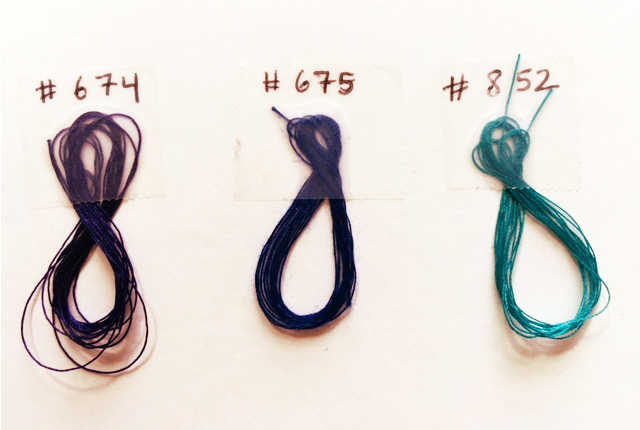
Why was I, after adjusting a pattern for fit and putting time into my sewing, still ending up with garments that were not quite right? I couldn’t quite figure it out and it didn’t happen every time but it happened enough not to be one bad pattern or one cut off grain fabric. If anything my sewing and fitting skills have only improved over the years so why was this problem happening more often?
I thought about it, and thought about it and like the mysteries I love to watch I had to ask questions to find some clues:
- Am I sewing more difficult garments and/or construction details? (maybe, but nothing I didn’t do in school)
- Am I using fabrics I can’t handle? (no, I am using simple wovens)
- Am I just being pickier about how the garment should look? (perhaps, but off is off no matter how low I lower my standards)
- When did this really start? Am I viewing my past sewing projects through rose colored glasses or has this problem always existed? (I do sew more so I have more opportunities to make mistakes but this problem is really in the last few years) (Coincidence?: I moved from a large metro area with an awesome fabric store about 10 years ago and a couple years ago my favorite local fabric store here, in my “new”, smallish town, closed)
There was more analyzing the “off” garments and after much thought I came to the conclusion that I am simply not choosing the correct fabric for the project. I don’t mean the color, or even the fiber, but rather the weight and drape of the fabric for the pattern. You can achieve a great fit but if the fabric doesn’t drape as the designer intended the final garment will not look right.
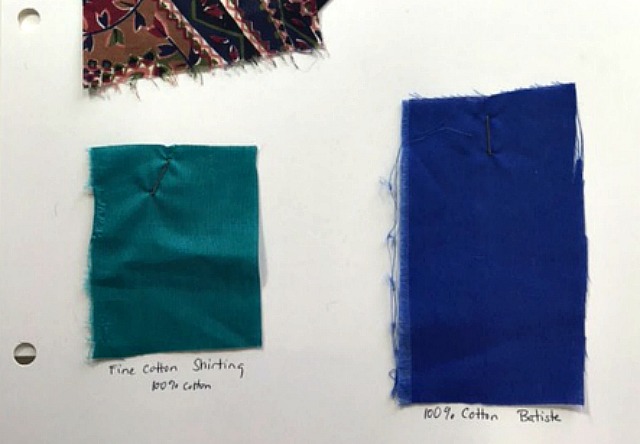
You have probably noticed that some patterns can be made up in almost any fabric where as other patterns are very limiting in fabric suggestions. Funny how that can work. And sometimes you think you know your fabrics, but even a simple fabric like a basic weave cotton can come in a wide range of weights. For instance, batiste, lawn, shirting, quilting and canvas could all be basic weave cottons. Mistakes can be made especially, as in my situation with very limited local fabric resources, when buying fabric online.
Apparently, feeling the fabric helps me to make the right choice. I know some online fabric stores will tell you the weight of the denim or linen, but what does that feel like? How densely woven is that shirting? How cheap does that rayon knit feel? I’ve seen on a site a cotton fabric labeled, “perfect for quilting and craft projects as well as apparel and home decor accents”. Well, apparel is a broad term. What are we dealing with exactly? No fabric is suitable for every apparel item. So how do you really know if it’s going to suit what you want to make?
I obviously need to learn my fabrics better and get more experience handling different weaves and weights; to learn what names go with what fabrics and what the characteristics are of the different fabrics.
Where would I get more experience handling fabrics? The fabric store. I started at the chain fabric store to feel and note different fabrics but they didn’t carry much besides polar fleece and quilting cottons. Then I went to a small dressmaker fabric store (which is my new favorite store) to see a crepe de chine and a charmuese, and anything else I could learn from. I learned that the bolts don’t always note the weave and the sales associate, though very nice, didn’t know some of the fabric names. Besides, I can’t make a trip to the store every time I can’t remember how ottoman and faille differ.
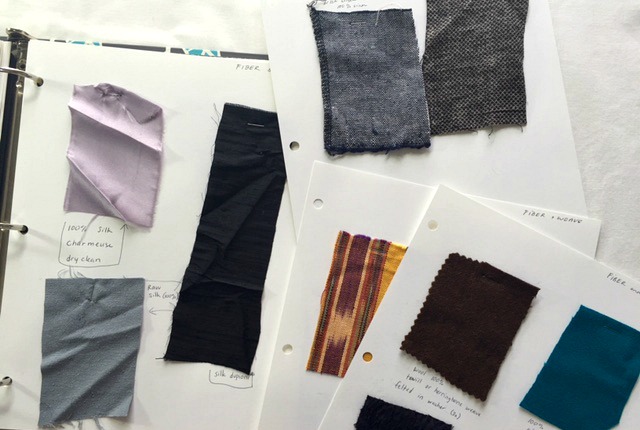
What I needed was a reference of fabric samples, labeled, so I could feel and see the qualities and differences of them all. I needed to put together a swatch binder where I could keep and touch fabric samples labeled with their fiber and weave. My much referenced copy of Claire Shaffer’s Fabric Sewing Guide wasn’t sticking with me. I guess I’m a tactile learner.
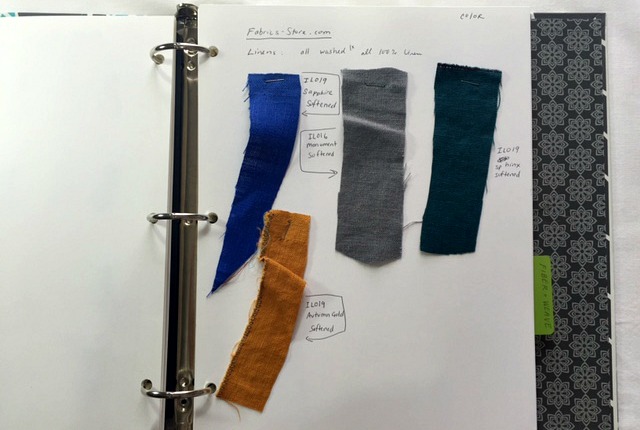
As I clipped fabric samples from my stash and dug out scraps from my scrap box I realized it would be nice to have samples of the different colors of the linen I frequently purchased because the colors can look different online than in person. Of course the same goes for thread colors since I now buy thread online too.
I also had with various projects made samples of stitches using different weight threads, or different needles, or different tension adjustments on my machine. Since I kept these to refer back to I figured they might as well be added to the binder as well.
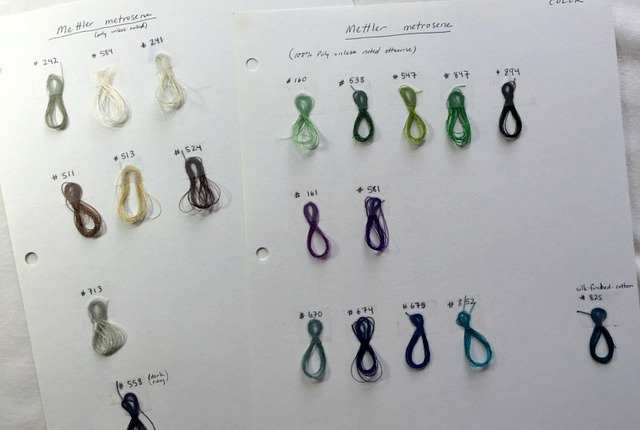
The point of keeping samples of fabrics is for easy reference and reassurance that you know what your ordering. For example while browsing online for no project in particular you see a fabric you’re drooling over. What is it? The description says 60/40 blend of x and y. What does that feel like? Can I use it for a skirt? What about for a shirt dress? Oh what do you know, you have a sample of that same blend in your swatch binder. After feeling it or remembering what you made from that fabric you know it’s going to be too stiff for a shirt dress but perfect for a skirt. Now you know how much yardage to order.
Or, the pattern you want to make list cotton voile in the fabric suggestions. You have a cotton in your stash that you think would be great for that pattern. You also have a sample of cotton voile in your swatch binder so you compare the cotton you want to use to the swatch of the suggested fabric and decide, yes, this cotton in your stash either is cotton voile or very similar and will work. Yay! The guess work of will it work or not is eliminated. There shouldn’t be any bad surprises after your done sewing it up; not as far as fabric drape at least.

Your fabric samples could be kept in a different way. I choose a binder because it suits the way I think and I had all the supplies already. You could go old school and use file cards in a index card box. You could use paper tags and hang them on a peg if you have a pegboard, or hook them onto a binder ring or an S-hook. You could sew all the samples in one long chain and hang them like decorative bunting (sticky labels on the back of each to identify) Just make it so you are able to compare fabrics side by side even if they aren’t stored side by side.
In my three ring binder I used card stock and a three-hole punch for the pages to which I simply stapled my fabric samples onto. Regular notebook paper is too flimsy for the weight of the fabrics. I stapled down the fabrics with one staple because I want to be able to feel the fabric between my thumb and fingers. If I had a big sample I kept it big so I could see the drape better.
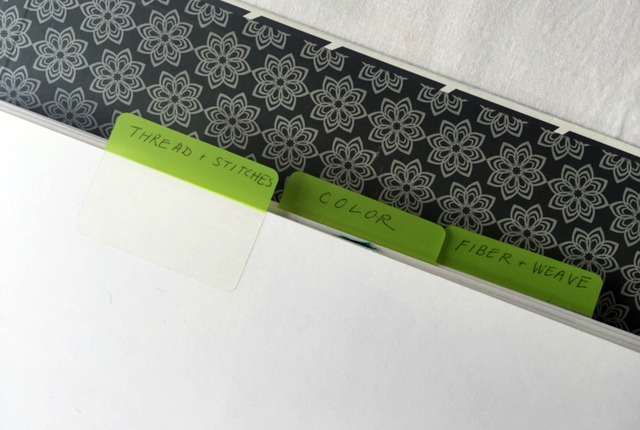
Every time you purchase a new type of fabric (a new weave, a new fiber, a new blend, a new color of your favorite fabric) cut off a swatch and add it to your binder. Note the fiber content, the weave, the care instructions if you know and any other information about the fabric that could be helpful like where you bought it in case you want more later. (Colette Patterns recommended taking a photo of the end of the bolt. This way, even months after buying the fabric you still have the care instructions when you get around to making the garment. I think that’s a great idea. You can leave the photo on your phone or transfer the info to your swatch binder.) Later you could also note what you made with the fabric and how well it held up.
Don’t be shy about asking friends for scraps of fabrics that your missing from your samples. Like trading cards, you could trade both a wide wale and a pin wale cord for a silk dupioni.
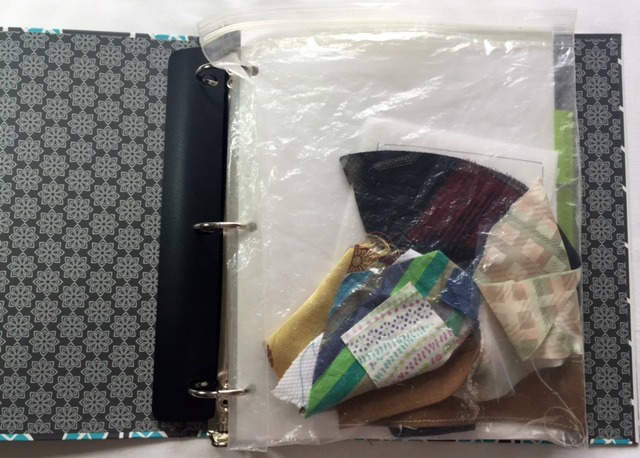
In Summary:
It’s helpful to have an organized way to keep fabric swatches. It allows you to learn and reference back to the qualities of different fabrics when purchasing fabric online and helps you decided if fabrics you already own can work for a particular project. Simply add to your swatch library as you obtain new fabrics. Note the fiber, the weave and any other information you would find useful. Store the samples in a way that you can rearrange them in order to compare them side by side or almost side by side. Refer back to your swatches when needed but chances are you’ll learn your fabrics better just by taking the time to add them to your swatch library. I know I have.
Here is a concise glossary of fabric terms which I found pretty helpful.
Do you keep samples of different fabrics? Do you buy types of fabrics you haven’t even felt before? What’s your experience buying fabric online?
